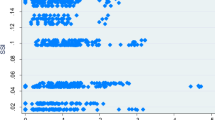Abstract
This paper examines the effect of trade sanctions on employment through their impact on total factor productivity by using Iranian industrial manufacturing data covering 7 years before and 7 years after the sanction. The first part of this study shows that the trade sanctions significantly reduced all industries’ total factor productivity both directly by reducing industries’ technology expenditure and indirectly by shrinking the magnitude of the effect of technology expenditure on total factor productivity. The second part of this study displays that there was remarkable job destruction, most notably in domestically active industries, during the sanctions years. Interestingly, the results from estimating a dynamic labor demand function depict that the job destruction during the sanction period can not be associated with the negative impact of trade sanctions on industries’ total factor productivity. In contrast, the results show that each 1% reduction in industries’ total factor productivity, which was indeed about 3.8% on average during the sanctions years, increases their employment by about 0.8% in the short-run and has no significant impact in the long-run.

Similar content being viewed by others
Notes
“Common Position 2008/652/CFSP.”
“Special Economic Measures (Iran) Regulations.”
The P5 + 1 refers to the UNSC’s five permanent members (the P5), namely China, France, Russia, the UK, and the USA, plus Germany.
The former president of Iran.
ADNKronos International, 24 December 2010.
BBC News Agency, 27 January 2017.
BBC interview, 3 October 2018.
Iran has 31 provinces now. Khorasan province was divided into three provinces (North Khorasan, South Khorasan, and Central Khorasan) in 2004, and Tehran province was divided into two provinces (Tehran and Alborz) in 2010. I combined these new provinces into the ones they were part of before the division.
Sum of imported raw materials and capital.
Many studies are mentioned in Isaksson (2007).
Haidar (2017)’ study covers the years between 2006 and 2011.
The only negative coefficient for the neither exports nor imports group is not statistically significant different from zero.
Assuming the capital and materials markets are perfect competition markets, the price of capital and materials will only change over time. Therefore, adding time dummies in estimation will capture the change in their prices over time.
References
Amiti M, Konings J (2007) Trade liberalization, intermediate inputs, and productivity: evidence from Indonesia. Am Econ Rev 97(5):1611–1638
Arellano M, Bond S (1991) Some tests of specification for panel data: monte carlo evidence and an application to employment equations. Rev Econ Studies 58(2):277–297
Bernard AB, Jensen JB (2004) Exporting and productivity in the USA. Oxf Rev Econ Policy 20(3):343–357
Bernard AB, Jensen JB, Lawrence RZ (1995) Exporters, jobs, and wages in US manufacturing: 1976-1987. Brookings Papers Econ Activity Microecon 1995:67–119
Davenport K (2018) The joint comprehensive plan of action (jcpoa) at a glance. Arm Control Assoc
Davis SJ, Haltiwanger J (1999) Gross job flows. Handbook Labor Economics 3:2711–2805
Felbermayr G, Syropoulos C, Yalcin E, Yotov Y et al (2020) On the heterogeneous effects of sanctions on trade and welfare: evidence from the sanctions on Iran and a new database. Technical Report LeBow College of Business, Drexel University
Galtung J (1967) Theories of peace: a synthetic approach to peace thinking. Int Peace Res Inst, Oslo, vol 2(6)
Greenaway D, Hine RC, Wright P (1999) An empirical assessment of the impact of trade on employment in the United Kingdom. European J Politic Econ 15(3):485–500
Haidar JI (2017) Sanctions and export deflection: evidence from Iran. Econ Policy 32(90):319–355
Halpern L, Koren M, Szeidl A (2005) Imports and productivity
Isaksson A (2007) Determinants of total factor productivity: a literature review. Res Stat Branch UNIDO 1:101
Jones RW (1956) Factor proportions and the Heckscher-Ohlin theorem. Rev Econ Studies 24(1):1–10
Kelishomi AM, Nisticò R (2022) Employment effects of economic sanctions in Iran. World Dev 151:105760
King RG, Thomas JK (2006) Partial adjustment without apology. Int Econ Rev 47(3):779–809
Ladu MG (2005) Total factor productivity growth and employment: a simultaneous equations model estimate
Melitz MJ (2003) The impact of trade on intra-industry reallocations and aggregate industry productivity. Econometrica 71(6):1695–1725
Morgan TC, Bapat N, Krustev V (2009) The threat and imposition of economic sanctions, 1971—2000. Conflict Manag Peace Sci 26(1):92–110
Nosratabadi J (2022) The impact of trade sanctions on the relative demand for skilled labor and wages: evidence from Iran. J Int Trade Econ Dev:1–21
Olly S, Pakes A (1996) The dynamics of productivity in the telecommunications equipment industry. Econometrica 64(6):1263–1297
Pavcnik N (2002) Trade liberalization, exit, and productivity improvements: evidence from Chilean plants. Rev Econ Stud 69(1):245–276
Thangavelu SM, Rajaguru G (2004) Is there an export or import-led productivity growth in rapidly developing asian countries? A multivariate var analysis. Appl Econ 36(10):1083–1093
Wagner J (2007) Exports and productivity: a survey of the evidence from firm-level data. World Econ 30(1):60–82
Author information
Authors and Affiliations
Corresponding author
Additional information
Publisher’s note
Springer Nature remains neutral with regard to jurisdictional claims in published maps and institutional affiliations.
Rights and permissions
Springer Nature or its licensor (e.g. a society or other partner) holds exclusive rights to this article under a publishing agreement with the author(s) or other rightsholder(s); author self-archiving of the accepted manuscript version of this article is solely governed by the terms of such publishing agreement and applicable law.
About this article
Cite this article
Nosratabadi, J. The effect of trade sanctions on employment through total factor productivity. Int Econ Econ Policy 20, 163–187 (2023). https://doi.org/10.1007/s10368-023-00555-y
Accepted:
Published:
Issue Date:
DOI: https://doi.org/10.1007/s10368-023-00555-y




